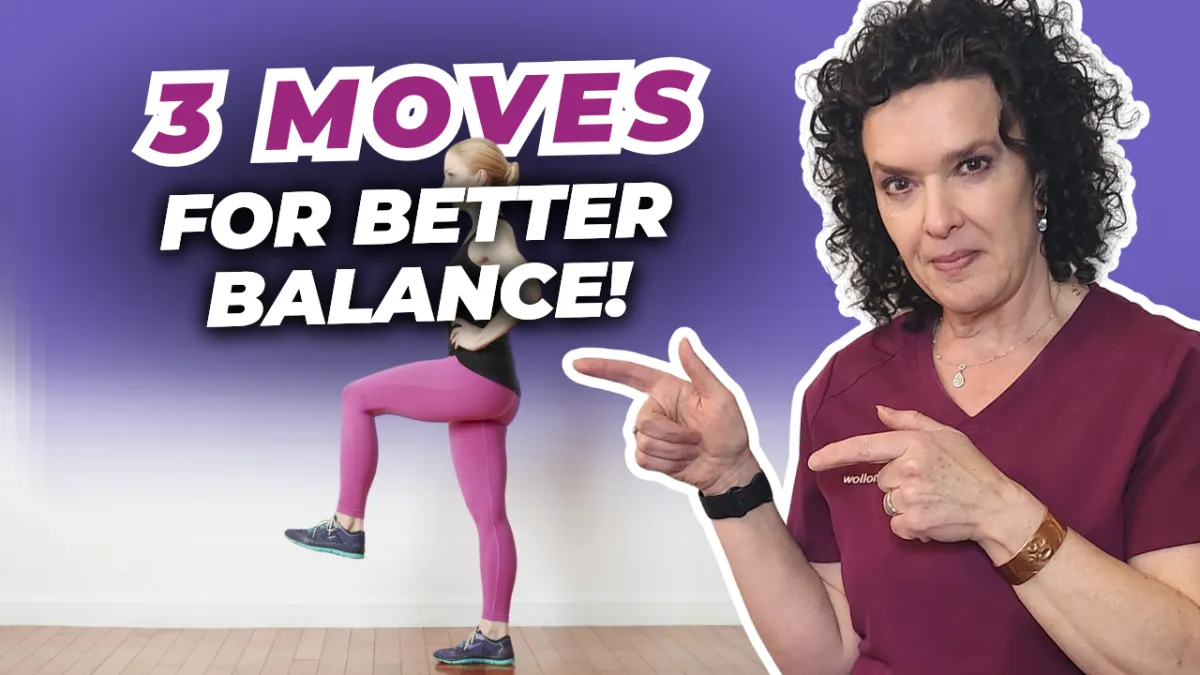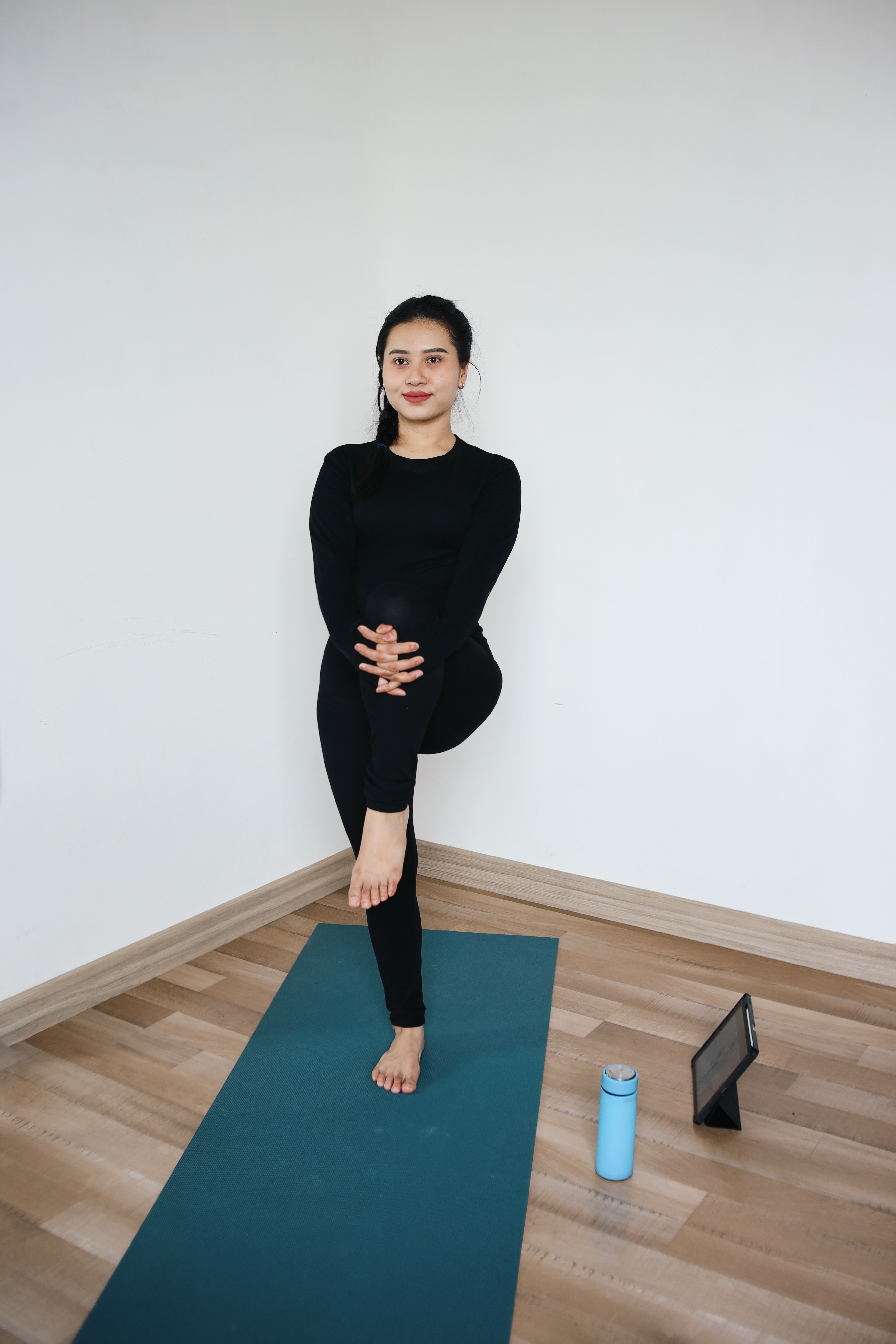
3 Easy Moves to Prevent Fall and Better Balance (Easy to Hard)
Ever catch yourself stumbling for no reason or feeling unsteady on your feet, even during simple daily movements? It might be more than just “getting older.”
In this episode, we dive into the hidden reasons behind poor balance. Learn how knee pain, past injuries, and weak core stability quietly affect the way your body moves. You’ll also hear about small, actionable steps you can take to improve your stability and prevent falls. All without a gym, equipment, or complicated routines.
Curious how just a few simple changes could help you feel stronger, steadier, and more confident? Dive in and find out.
Episode Video

Struggling With Knee Pain or Poor Balance?
It usually starts small. Maybe you trip over a rug, wobble while stepping off a curb, or hesitate before climbing stairs. You brush it off, “just got off balance,” you say. But over time, these moments start to add up. If you’ve been dealing with knee pain, back stiffness, or even just feeling unsteady, there’s a deeper reason your body might be giving you these warning signs.
Balance isn’t just about coordination. It’s about how well your brain, muscles, nerves, and joints work together. When one part of that system breaks down, especially your core or knees, it can affect everything from your posture to how safely you walk.
The good news? You can absolutely improve your balance, reduce knee pain, and feel more in control of your body. All from home, without any fancy gym equipment.
Why Balance Gets Worse With Age (and Pain)
Balance is often one of the first things to decline as we get older, but most people don’t notice until it’s too late. It’s only after a fall or a scary near-miss that balance becomes a priority. But by then, the systems responsible for keeping you upright, your knees, hips, core, and brain, may already be weakened.
Pain plays a major role, especially knee pain. When a joint hurts, the surrounding muscles often tighten up to “protect” the area. This guarding limits your range of motion and weakens stability. Old ankle injuries, poor posture, and spinal issues also contribute by interfering with the brain’s ability to coordinate movement effectively.
Another big factor? Core instability. Your core isn’t just your abs. It includes your back, pelvis, and hips. When your core muscles are weak or untrained, your body struggles to keep itself centered during even simple activities like walking, turning, or reaching.
The 3 Best Balance Exercises to Improve Stability and Reduce Knee Pain
These exercises are designed to re-train your brain, build your core, and strengthen your legs—all while being gentle on your joints. Each one has beginner, intermediate, and advanced options so you can progress at your own pace.
One-Leg Stand
Start by standing near a sturdy surface for safety. Lift one foot off the ground and balance on the other leg. Extend your arms if needed. Focus your eyes on a fixed point ahead of you. Try holding for 30 seconds.
This move helps train the brain to use multiple systems at once: your visual system, your inner ear, your proprioception (sense of position), and your core stability. It also activates the small stabilizing muscles around your ankles, knees, and hips. These are the key areas affected by pain or past injury.
Want to make it harder? Close your eyes. Without visual input, your core and inner ear have to work harder. For the advanced version, slowly turn your head side to side while balancing. This simulates real-life distractions, like looking around while walking.
You can practice this while brushing your teeth, standing in line, or even waiting for the microwave. It’s that easy and that effective.
Heel-to-Toe Walk
Walk in a straight line, placing your heel directly in front of your toes with each step. Go slowly. Once you’ve mastered the forward walk, try it in reverse. It’s more challenging than it sounds.
To further improve coordination, turn your head gently from left to right as you walk. This mimics real-world multitasking, like scanning for cars while walking through a parking lot.
This exercise enhances foot coordination, strengthens the arches, and improves balance in motion, making it ideal for people recovering from knee pain or lower-body injuries. It forces your body to rely on proprioception and muscle memory to stay upright, which are crucial for preventing future falls.
Sit-to-Stand Without Using Hands
Sit in a sturdy chair with your feet flat on the floor. Without using your hands, push yourself up to standing as quickly as you can. Then slowly lower yourself back down. Repeat for 8 to 10 reps.
This works your quads and hamstrings, the two muscle groups that support your knees, as well as your glutes and lower back. It also challenges your core stability by making you control your motion both on the way up and down.
This move is more than just leg strength. It’s about training your nervous system to respond quickly. That kind of explosive power is what helps you catch yourself if you trip or stumble.
Bonus Move: Single-Leg Leg Swings
Feeling confident? Here’s a challenge. Stand on one leg and slowly swing your other leg out to the side, then diagonally backward, then straight back. Return the same way. Switch legs and repeat.
This dynamic move trains your balance across multiple directions, just like life. It forces your body to stabilize during motion, which builds resilience in your hips, knees, and ankles. It’s excellent for improving core stability for balance under real-world conditions.
The Link Between Nutrition and Better Balance
You can’t just train your muscles. You also have to feed them. Balance and mobility don’t just depend on strength; they rely on your nervous system, bones, and connective tissue too. Here’s how to fuel those systems properly.
Support Your Muscles and Nerves With Electrolytes
Your muscles can’t move without signals from your nerves. That signaling depends on electrolytes, especially potassium, magnesium, and calcium.
If you're low in any of these, you may feel muscle cramps, weakness, or shakiness. All of which can contribute to poor balance and knee pain. To stay steady, eat foods like:
Bananas, sweet potatoes, spinach, and beets (for potassium)
Avocados, beans, and leafy greens (for magnesium)
Yogurt, cheese, and fortified non-dairy milks (for calcium)
These minerals help your muscles fire correctly and maintain strength during movement.
Reduce Inflammation With Omega-3s and Antioxidants
Chronic inflammation slows down your reflexes and makes it harder for muscles to respond quickly. If your body is inflamed, your nervous system doesn’t work efficiently—putting you at risk of falls.
To reduce inflammation, add omega-3-rich foods like salmon, sardines, walnuts, and chia seeds. Antioxidant-rich foods like berries, cherries, and leafy greens also help.
A Mediterranean-style diet with olive oil, nuts, and vegetables supports both anti-inflammatory action and muscle health. These are key to maintaining core stability for balance over time.
Build Strong Bones and Healthy Nerves With Key Vitamins
To maintain bone density and proper nerve function, your body needs vitamin D, B vitamins, calcium, and magnesium.
Vitamin D supports calcium absorption and can be found in sunlight, fortified dairy and plant milks, and fish.
B vitamins (especially B6 and B12) help nerves function properly. These are found in eggs, whole grains, and legumes.
Calcium and magnesium help keep bones strong and muscles responsive.
A strong skeleton supports powerful muscles. When the bones are weak, the muscles have to overcompensate, leading to more pain, especially in the knees.
Final Thoughts
If you’ve been ignoring those subtle signs of instability, hesitating before walking, feeling off-center, or struggling with knee pain, now is the time to act. These balance exercises and simple lifestyle changes can help you rebuild strength, prevent falls, and regain control of your body. You don’t need to be in a gym or physical therapy office. Just a few minutes a day at home, paired with smart nutrition, can transform the way you move.
Remember: balance is not something that just fades with age. It's a skill, and like any skill, it can be trained, strengthened, and maintained.
If you're ready to take control of your knee pain, click here to discover more about these five effective knee pain home treatments. With these simple steps, you can start your journey towards pain-free knees and a more active lifestyle.
